Advanced Applications of Porous Materials in Triboelectric Nanogenerator Self-Powered Sensors
Abstract
:1. Introduction
2. Structure and Function
2.1. Aerogels
2.2. Foam Sponge

2.3. Electrospinning
2.4. Three-Dimensional Printing
2.5. Fabric
3. Performance Enhancement Strategies
3.1. Mechanical Performance
3.2. Electrical Performance
3.3. Gas Responsiveness Characteristics
3.4. Environmental Tolerance Performance
3.5. Others
4. Sensing Applications
4.1. Pressure Sensing
4.2. Gas Sensing
4.3. Health Monitoring
4.4. Human–Computer Interactions
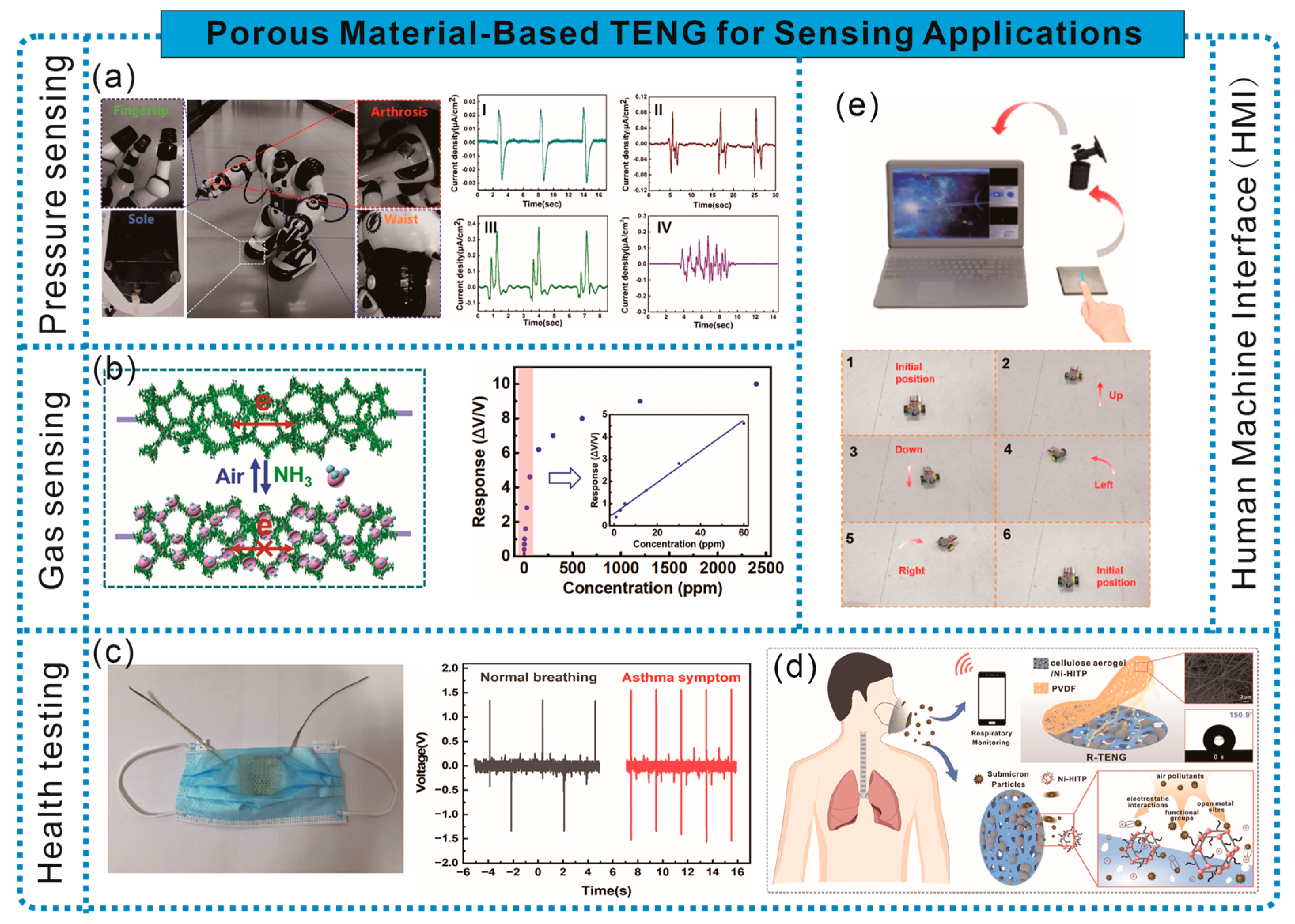
5. Summary and Outlook
Author Contributions
Funding
Conflicts of Interest
References
- Wu, J.; Zheng, Y.; Li, X. Recent Progress in Self-Powered Sensors Based on Triboelectric Nanogenerators. Sensors 2021, 21, 7129. [Google Scholar] [CrossRef] [PubMed]
- Ishizaki, K.; Komarneni, S.; Nanko, M. Introduction. In Porous Materials; Springer: Boston, MA, USA, 1998; pp. 1–11. ISBN 978-1-4615-5811-8. [Google Scholar]
- Zhao, D.; Zhao, T. Pore Engineering for High Performance Porous Materials. ACS Cent. Sci. 2023, 9, 1499–1503. [Google Scholar] [CrossRef] [PubMed]
- Chen, W.; Gan, L.; Huang, J. Design, Manufacturing and Functions of Pore-Structured Materials: From Biomimetics to Artificial. Biomimetics 2023, 8, 140. [Google Scholar] [CrossRef] [PubMed]
- Siddique, S.H.; Hazell, P.J.; Wang, H.; Escobedo, J.P.; Ameri, A.A.H. Lessons from Nature: 3D Printed Bio-Inspired Porous Structures for Impact Energy Absorption—A Review. Addit. Manuf. 2022, 58, 103051. [Google Scholar] [CrossRef]
- Rastegardoost, M.M.; Tafreshi, O.A.; Saadatnia, Z.; Ghaffari-Mosanenzadeh, S.; Park, C.B.; Naguib, H.E. Recent Advances on Porous Materials and Structures for High-Performance Triboelectric Nanogenerators. Nano Energy 2023, 111, 108365. [Google Scholar] [CrossRef]
- Mi, Y.; Zhao, Z.; Wu, H.; Lu, Y.; Wang, N. Porous Polymer Materials in Triboelectric Nanogenerators: A Review. Polymers 2023, 15, 4383. [Google Scholar] [CrossRef] [PubMed]
- Tetik, H.; Wang, Y.; Sun, X.; Cao, D.; Shah, N.; Zhu, H.; Qian, F.; Lin, D. Additive Manufacturing of 3D Aerogels and Porous Scaffolds: A Review. Adv. Funct. Mater. 2021, 31, 2103410. [Google Scholar] [CrossRef]
- Abraham, E.; Cherpak, V.; Senyuk, B.; Ten Hove, J.B.; Lee, T.; Liu, Q.; Smalyukh, I.I. Highly Transparent Silanized Cellulose Aerogels for Boosting Energy Efficiency of Glazing in Buildings. Nat. Energy 2023, 8, 381–396. [Google Scholar] [CrossRef]
- Gong, C.; Ni, J.; Tian, C.; Su, Z. Research in Porous Structure of Cellulose Aerogel Made from Cellulose Nanofibrils. Int. J. Biol. Macromol. 2021, 172, 573–579. [Google Scholar] [CrossRef]
- Saadatnia, Z.; Mosanenzadeh, S.G.; Esmailzadeh, E.; Naguib, H.E. A High Performance Triboelectric Nanogenerator Using Porous Polyimide Aerogel Film. Sci. Rep. 2019, 9, 1370. [Google Scholar] [CrossRef]
- Saadatnia, Z.; Mosanenzadeh, S.G.; Li, T.; Esmailzadeh, E.; Naguib, H.E. Polyurethane Aerogel-Based Triboelectric Nanogenerator for High Performance Energy Harvesting and Biomechanical Sensing. Nano Energy 2019, 65, 104019. [Google Scholar] [CrossRef]
- Roy, S.; Maji, P.K.; Goh, K.-L. Sustainable Design of Flexible 3D Aerogel from Waste PET Bottle for Wastewater Treatment to Energy Harvesting Device. Chem. Eng. J. 2021, 413, 127409. [Google Scholar] [CrossRef]
- Luo, C.; Ma, H.; Yu, H.; Zhang, Y.; Shao, Y.; Yin, B.; Ke, K.; Zhou, L.; Zhang, K.; Yang, M.-B. Enhanced Triboelectric Nanogenerator Based on a Hybrid Cellulose Aerogel for Energy Harvesting and Self-Powered Sensing. ACS Sustain. Chem. Eng. 2023, 11, 9424–9432. [Google Scholar] [CrossRef]
- Wang, Z.; Chen, C.; Fang, L.; Cao, B.; Tu, X.; Zhang, R.; Dong, K.; Lai, Y.-C.; Wang, P. Biodegradable, Conductive, Moisture-Proof, and Dielectric Enhanced Cellulose-Based Triboelectric Nanogenerator for Self-Powered Human-Machine Interface Sensing. Nano Energy 2023, 107, 108151. [Google Scholar] [CrossRef]
- Huang, T.; Long, Y.; Dong, Z.; Hua, Q.; Niu, J.; Dai, X.; Wang, J.; Xiao, J.; Zhai, J.; Hu, W. Ultralight, Elastic, Hybrid Aerogel for Flexible/Wearable Piezoresistive Sensor and Solid–Solid/Gas–Solid Coupled Triboelectric Nanogenerator. Adv. Sci. 2022, 9, 2204519. [Google Scholar] [CrossRef] [PubMed]
- Ahmed, A.; El-Kady, M.F.; Hassan, I.; Negm, A.; Pourrahimi, A.M.; Muni, M.; Selvaganapathy, P.R.; Kaner, R.B. Fire-Retardant, Self-Extinguishing Triboelectric Nanogenerators. Nano Energy 2019, 59, 336–345. [Google Scholar] [CrossRef]
- Li, Z.; Hu, K.; Yang, M.; Zou, Y.; Yang, J.; Yu, M.; Wang, H.; Qu, X.; Tan, P.; Wang, C.; et al. Elastic Cu@PPy Sponge for Hybrid Device with Energy Conversion and Storage. Nano Energy 2019, 58, 852–861. [Google Scholar] [CrossRef]
- Niu, Z.; Zhou, W.; Chen, X.; Chen, J.; Xie, S. Highly Compressible and All-Solid-State Supercapacitors Based on Nanostructured Composite Sponge. Adv. Mater. 2015, 27, 6002–6008. [Google Scholar] [CrossRef] [PubMed]
- Xiao, K.; Ding, L.-X.; Liu, G.; Chen, H.; Wang, S.; Wang, H. Freestanding, Hydrophilic Nitrogen-Doped Carbon Foams for Highly Compressible All Solid-State Supercapacitors. Adv. Mater. 2016, 28, 5997–6002. [Google Scholar] [CrossRef]
- Chen, W.; Rakhi, R.B.; Hu, L.; Xie, X.; Cui, Y.; Alshareef, H.N. High-Performance Nanostructured Supercapacitors on a Sponge. Nano Lett. 2011, 11, 5165–5172. [Google Scholar] [CrossRef]
- Yang, L.; Liu, C.; Yuan, W.; Meng, C.; Dutta, A.; Chen, X.; Guo, L.; Niu, G.; Cheng, H. Fully Stretchable, Porous MXene-Graphene Foam Nanocomposites for Energy Harvesting and Self-Powered Sensing. Nano Energy 2022, 103, 107807. [Google Scholar] [CrossRef]
- Cui, X.; Zhao, T.; Yang, S.; Xie, G.; Zhang, Z.; Zhang, Y.; Sang, S.; Lin, Z.-H.; Zhang, W.; Zhang, H. A Spongy Electrode-Brush-Structured Dual-Mode Triboelectric Nanogenerator for Harvesting Mechanical Energy and Self-Powered Trajectory Tracking. Nano Energy 2020, 78, 105381. [Google Scholar] [CrossRef]
- Park, J.; Kim, I.; Yun, J.; Kim, D. Liquid-Metal Embedded Sponge-Typed Triboelectric Nanogenerator for Omnidirectionally Detectable Self-Powered Motion Sensor. Nano Energy 2021, 89, 106442. [Google Scholar] [CrossRef]
- Kim, W.-G.; Kim, D.; Jeon, S.-B.; Park, S.-J.; Tcho, I.-W.; Jin, I.-K.; Han, J.-K.; Choi, Y.-K. Multidirection and Multiamplitude Triboelectric Nanogenerator Composed of Porous Conductive Polymer with Prolonged Time of Current Generation. Adv. Energy Mater. 2018, 8, 1800654. [Google Scholar] [CrossRef]
- Kou, H.; Wang, H.; Cheng, R.; Liao, Y.; Shi, X.; Luo, J.; Li, D.; Wang, Z.L. Smart Pillow Based on Flexible and Breathable Triboelectric Nanogenerator Arrays for Head Movement Monitoring during Sleep. ACS Appl. Mater. Interfaces 2022, 14, 23998–24007. [Google Scholar] [CrossRef]
- Kim, D.; Park, S.-J.; Jeon, S.-B.; Seol, M.-L.; Choi, Y.-K. A Triboelectric Sponge Fabricated from a Cube Sugar Template by 3D Soft Lithography for Superhydrophobicity and Elasticity. Adv. Electron. Mater. 2016, 2, 1500331. [Google Scholar] [CrossRef]
- Wang, M.; Zhang, N.; Tang, Y.; Zhang, H.; Ning, C.; Tian, L.; Li, W.; Zhang, J.; Mao, Y.; Liang, E. Single-Electrode Triboelectric Nanogenerators Based on Sponge-like Porous PTFE Thin Films for Mechanical Energy Harvesting and Self-Powered Electronics. J. Mater. Chem. A 2017, 5, 12252–12257. [Google Scholar] [CrossRef]
- Pharino, U.; Sinsanong, Y.; Pongampai, S.; Charoonsuk, T.; Pakawanit, P.; Sriphan, S.; Vittayakorn, N.; Vittayakorn, W. Influence of Pore Morphologies on the Mechanical and Tribo-Electrical Performance of Polydimethylsiloxane Sponge Fabricated via Commercial Seasoning Templates. Radiat. Phys. Chem. 2021, 189, 109720. [Google Scholar] [CrossRef]
- Liu, Y.-Z.; Zhang, Q.; Wang, X.-X.; Lu, Y.; Li, W.-B.; Peng, Q.-Y.; Xu, F.-Y. Review of Electrospinning in the Fabrication of Nanogenerators. ACS Appl. Nano Mater. 2024, 7, 4630–4652. [Google Scholar] [CrossRef]
- Babu, A.; Aazem, I.; Walden, R.; Bairagi, S.; Mulvihill, D.M.; Pillai, S.C. Electrospun Nanofiber Based TENGs for Wearable Electronics and Self-Powered Sensing. Chem. Eng. J. 2023, 452, 139060. [Google Scholar] [CrossRef]
- Peng, X.; Dong, K.; Ning, C.; Cheng, R.; Yi, J.; Zhang, Y.; Sheng, F.; Wu, Z.; Wang, Z.L. All-Nanofiber Self-Powered Skin-Interfaced Real-Time Respiratory Monitoring System for Obstructive Sleep Apnea-Hypopnea Syndrome Diagnosing. Adv. Funct. Mater. 2021, 31, 2103559. [Google Scholar] [CrossRef]
- Lee, C.; Cho, C.; Oh, J.H. Highly Flexible Triboelectric Nanogenerators with Electrospun PVDF-TrFE Nanofibers on MWCNTs/PDMS/AgNWs Composite Electrodes. Compos. Part B Eng. 2023, 255, 110622. [Google Scholar] [CrossRef]
- Qiu, Y.; Fang, H.; Guo, J.; Wu, H. Fully Nano/Micro-Fibrous Triboelectric on-Skin Patch with High Breathability and Hydrophobicity for Physiological Status Monitoring. Nano Energy 2022, 98, 107311. [Google Scholar] [CrossRef]
- Rahman, M.T.; Rana, S.S.; Zahed, M.A.; Lee, S.; Yoon, E.-S.; Park, J.Y. Metal-Organic Framework-Derived Nanoporous Carbon Incorporated Nanofibers for High-Performance Triboelectric Nanogenerators and Self-Powered Sensors. Nano Energy 2022, 94, 106921. [Google Scholar] [CrossRef]
- Zhong, J.; Hou, X.; He, J.; Xue, F.; Yang, Y.; Chen, L.; Yu, J.; Mu, J.; Geng, W.; Chou, X. Asymmetric Permittivity Enhanced Bilayer Polycaprolactone Nanofiber with Superior Inner Interfacial Polarization and Charge Retention for High-Output and Humidity-Resistant Triboelectric Nanogenerators. Nano Energy 2022, 98, 107289. [Google Scholar] [CrossRef]
- Zhang, W.; Lu, Y.; Liu, T.; Zhao, J.; Liu, Y.; Fu, Q.; Mo, J.; Cai, C.; Nie, S. Spheres Multiple Physical Network-Based Triboelectric Materials for Self-Powered Contactless Sensing. Small 2022, 18, 2200577. [Google Scholar] [CrossRef] [PubMed]
- Rastegardoost, M.M.; Tafreshi, O.A.; Saadatnia, Z.; Ghaffari-Mosanenzadeh, S.; Park, C.B.; Naguib, H.E. Porous PVDF Mats with Significantly Enhanced Dielectric Properties and Novel Dipole Arrangement for High-Performance Triboelectric Nanogenerators. Appl. Mater. Today 2023, 30, 101732. [Google Scholar] [CrossRef]
- Cai, N.; Sun, P.; Jiang, S. Rapid Prototyping and Customizable Multifunctional Structures: 3D-Printing Technology Promotes the Rapid Development of TENGs. J. Mater. Chem. A 2021, 9, 16255–16280. [Google Scholar] [CrossRef]
- Valentine, A.D.; Busbee, T.A.; Boley, J.W.; Raney, J.R.; Chortos, A.; Kotikian, A.; Berrigan, J.D.; Durstock, M.F.; Lewis, J.A. Hybrid 3D Printing of Soft Electronics. Adv. Mater. 2017, 29, 1703817. [Google Scholar] [CrossRef]
- Prabhu, S.R.; Ilangkumaran, M.; Mohanraj, T. 3D Printing of Automobile Spoilers Using MCDM Techniques. Mater. Test. 2020, 62, 1121–1125. [Google Scholar] [CrossRef]
- Aquino, R.P.; Barile, S.; Grasso, A.; Saviano, M. Envisioning Smart and Sustainable Healthcare: 3D Printing Technologies for Personalized Medication. Futures 2018, 103, 35–50. [Google Scholar] [CrossRef]
- Chen, S.; Huang, T.; Zuo, H.; Qian, S.; Guo, Y.; Sun, L.; Lei, D.; Wu, Q.; Zhu, B.; He, C.; et al. A Single Integrated 3D-Printing Process Customizes Elastic and Sustainable Triboelectric Nanogenerators for Wearable Electronics. Adv. Funct. Mater. 2018, 28, 1805108. [Google Scholar] [CrossRef]
- He, S.; Yu, Z.; Zhou, H.; Huang, Z.; Zhang, Y.; Li, Y.; Li, J.; Wang, Y.; Li, D. Polymer Tubes as Carrier Boats of Thermosetting and Powder Materials Based on 3D Printing for Triboelectric Nanogenerator with Microstructure. Nano Energy 2018, 52, 134–141. [Google Scholar] [CrossRef]
- Qian, C.; Li, L.; Gao, M.; Yang, H.; Cai, Z.; Chen, B.; Xiang, Z.; Zhang, Z.; Song, Y. All-Printed 3D Hierarchically Structured Cellulose Aerogel Based Triboelectric Nanogenerator for Multi-Functional Sensors. Nano Energy 2019, 63, 103885. [Google Scholar] [CrossRef]
- Chen, C.; Guo, H.; Chen, L.; Wang, Y.-C.; Pu, X.; Yu, W.; Wang, F.; Du, Z.; Wang, Z.L. Direct Current Fabric Triboelectric Nanogenerator for Biomotion Energy Harvesting. ACS Nano 2020, 14, 4585–4594. [Google Scholar] [CrossRef] [PubMed]
- He, T.; Wang, H.; Wang, J.; Tian, X.; Wen, F.; Shi, Q.; Ho, J.S.; Lee, C. Self-Sustainable Wearable Textile Nano-Energy Nano-System (NENS) for Next-Generation Healthcare Applications. Adv. Sci. 2019, 6, 1901437. [Google Scholar] [CrossRef]
- Doganay, D.; Cicek, M.O.; Durukan, M.B.; Altuntas, B.; Agbahca, E.; Coskun, S.; Unalan, H.E. Fabric Based Wearable Triboelectric Nanogenerators for Human Machine Interface. Nano Energy 2021, 89, 106412. [Google Scholar] [CrossRef]
- Gao, Y.; Xu, B.; Tan, D.; Li, M.; Wang, Y.; Yang, Y. Asymmetric-Elastic-Structure Fabric-Based Triboelectric Nanogenerators for Wearable Energy Harvesting and Human Motion Sensing. Chem. Eng. J. 2023, 466, 143079. [Google Scholar] [CrossRef]
- Hu, S.; Han, J.; Shi, Z.; Chen, K.; Xu, N.; Wang, Y.; Zheng, R.; Tao, Y.; Sun, Q.; Wang, Z.L.; et al. Biodegradable, Super-Strong, and Conductive Cellulose Macrofibers for Fabric-Based Triboelectric Nanogenerator. Nano-Micro Lett. 2022, 14, 115. [Google Scholar] [CrossRef]
- Chen, K.; Li, Y.; Yang, G.; Hu, S.; Shi, Z.; Yang, G. Fabric-Based TENG Woven with Bio-Fabricated Superhydrophobic Bacterial Cellulose Fiber for Energy Harvesting and Motion Detection. Adv. Funct. Mater. 2023, 33, 2304809. [Google Scholar] [CrossRef]
- He, J.; Xue, Y.; Liu, H.; Li, J.; Liu, Q.; Zhao, Y.; Mu, L.; Sun, C.-L.; Qu, M. Humidity-Resistant, Conductive Fabric-Based Triboelectric Nanogenerator for Efficient Energy Harvesting and Human–Machine Interaction Sensing. ACS Appl. Mater. Interfaces 2023, 15, 43963–43975. [Google Scholar] [CrossRef] [PubMed]
- Fang, Y.; Xu, J.; Xiao, X.; Zou, Y.; Zhao, X.; Zhou, Y.; Chen, J. A Deep-Learning-Assisted On-Mask Sensor Network for Adaptive Respiratory Monitoring. Adv. Mater. 2022, 34, 2200252. [Google Scholar] [CrossRef] [PubMed]
- Libanori, A.; Chen, G.; Zhao, X.; Zhou, Y.; Chen, J. Smart Textiles for Personalized Healthcare. Nat. Electron. 2022, 5, 142–156. [Google Scholar] [CrossRef]
- Lee, K.Y.; Chun, J.; Lee, J.-H.; Kim, K.N.; Kang, N.-R.; Kim, J.-Y.; Kim, M.H.; Shin, K.-S.; Gupta, M.K.; Baik, J.M.; et al. Hydrophobic Sponge Structure-Based Triboelectric Nanogenerator. Adv. Mater. 2014, 26, 5037–5042. [Google Scholar] [CrossRef] [PubMed]
- Luo, B.; Cai, C.; Liu, T.; Meng, X.; Zhuang, X.; Liu, Y.; Gao, C.; Chi, M.; Zhang, S.; Wang, J.; et al. Multiscale Structural Nanocellulosic Triboelectric Aerogels Induced by Hofmeister Effect. Adv. Funct. Mater. 2023, 33, 2306810. [Google Scholar] [CrossRef]
- Peng, M.; Wen, Z.; Xie, L.; Cheng, J.; Jia, Z.; Shi, D.; Zeng, H.; Zhao, B.; Liang, Z.; Li, T.; et al. 3D Printing of Ultralight Biomimetic Hierarchical Graphene Materials with Exceptional Stiffness and Resilience. Adv. Mater. 2019, 31, 1902930. [Google Scholar] [CrossRef] [PubMed]
- Lei, H.; Cao, K.; Chen, Y.; Liang, Z.; Wen, Z.; Jiang, L.; Sun, X. 3D-Printed Endoplasmic Reticulum rGO Microstructure Based Self-Powered Triboelectric Pressure Sensor. Chem. Eng. J. 2022, 445, 136821. [Google Scholar] [CrossRef]
- Lei, H.; Xiao, J.; Chen, Y.; Jiang, J.; Xu, R.; Wen, Z.; Dong, B.; Sun, X. Bamboo-Inspired Self-Powered Triboelectric Sensor for Touch Sensing and Sitting Posture Monitoring. Nano Energy 2022, 91, 106670. [Google Scholar] [CrossRef]
- Li, Y.; Xiao, S.; Zhang, X.; Jia, P.; Tian, S.; Pan, C.; Zeng, F.; Chen, D.; Chen, Y.; Tang, J.; et al. Silk Inspired In-Situ Interlocked Superelastic Microfibers for Permeable Stretchable Triboelectric Nanogenerator. Nano Energy 2022, 98, 107347. [Google Scholar] [CrossRef]
- Mi, H.-Y.; Jing, X.; Zheng, Q.; Fang, L.; Huang, H.-X.; Turng, L.-S.; Gong, S. High-Performance Flexible Triboelectric Nanogenerator Based on Porous Aerogels and Electrospun Nanofibers for Energy Harvesting and Sensitive Self-Powered Sensing. Nano Energy 2018, 48, 327–336. [Google Scholar] [CrossRef]
- Zhao, J.; Zhang, W.; Liu, T.; Liu, Y.; Qin, Y.; Mo, J.; Cai, C.; Zhang, S.; Nie, S. Hierarchical Porous Cellulosic Triboelectric Materials for Extreme Environmental Conditions. Small Methods 2022, 6, 2200664. [Google Scholar] [CrossRef] [PubMed]
- Wang, F.; Wang, S.; Liu, Y.; Hou, T.; Wu, Z.; Qian, J.; Zhao, Z.; Wang, L.; Jia, C.; Ma, S. Improved Electrical Output Performance of Cellulose-Based Triboelectric Nanogenerators Enabled by Negative Triboelectric Materials. Small 2023, 20, 2308195. [Google Scholar] [CrossRef] [PubMed]
- Haider, Z.; Haleem, A.; Ahmad, R.u.S.; Farooq, U.; Shi, L.; Claver, U.P.; Memon, K.; Fareed, A.; Khan, I.; Mbogba, M.K.; et al. Highly Porous Polymer Cryogel Based Tribopositive Material for High Performance Triboelectric Nanogenerators. Nano Energy 2020, 68, 104294. [Google Scholar] [CrossRef]
- Tang, Y.; Zheng, Q.; Chen, B.; Ma, Z.; Gong, S. A New Class of Flexible Nanogenerators Consisting of Porous Aerogel Films Driven by Mechanoradicals. Nano Energy 2017, 38, 401–411. [Google Scholar] [CrossRef]
- Chen, J.; Guo, H.; He, X.; Liu, G.; Xi, Y.; Shi, H.; Hu, C. Enhancing Performance of Triboelectric Nanogenerator by Filling High Dielectric Nanoparticles into Sponge PDMS Film. ACS Appl. Mater. Interfaces 2016, 8, 736–744. [Google Scholar] [CrossRef] [PubMed]
- Xia, X.; Chen, J.; Guo, H.; Liu, G.; Wei, D.; Xi, Y.; Wang, X.; Hu, C. Embedding Variable Micro-Capacitors in Polydimethylsiloxane for Enhancing Output Power of Triboelectric Nanogenerator. Nano Res. 2017, 10, 320–330. [Google Scholar] [CrossRef]
- Haleem, A.; Haider, Z.; Ahmad, R.u.S.; Claver, U.P.; Shah, A.; Zhao, G.; He, W.-D. Highly Porous and Thermally Stable Tribopositive Hybrid Bimetallic Cryogel to Boost up the Performance of Triboelectric Nanogenerators. Int. J. Energy Res. 2020, 44, 8442–8454. [Google Scholar] [CrossRef]
- Chun, J.; Kim, J.W.; Jung, W.; Kang, C.-Y.; Kim, S.-W.; Wang, Z.L.; Baik, J.M. Mesoporous Pores Impregnated with Au Nanoparticles as Effective Dielectrics for Enhancing Triboelectric Nanogenerator Performance in Harsh Environments. Energy Environ. Sci. 2015, 8, 3006–3012. [Google Scholar] [CrossRef]
- Biutty, M.N.; Koo, J.M.; Zakia, M.; Handayani, P.L.; Choi, U.H.; Yoo, S.I. Dielectric Control of Porous Polydimethylsiloxane Elastomers with Au Nanoparticles for Enhancing the Output Performance of Triboelectric Nanogenerators. RSC Adv. 2020, 10, 21309–21317. [Google Scholar] [CrossRef]
- Flores, J.M.B.; García, M.G.P.; Contreras, G.G.; Mendoza, A.C.; Arellano, V.H.R. Polydimethylsiloxane Nanocomposite Macroporous Films Prepared via Pickering High Internal Phase Emulsions as Effective Dielectrics for Enhancing the Performance of Triboelectric Nanogenerators. RSC Adv. 2020, 11, 416–424. [Google Scholar] [CrossRef]
- Gao, C.; Zhang, W.; Liu, T.; Luo, B.; Cai, C.; Chi, M.; Zhang, S.; Liu, Y.; Wang, J.; Zhao, J.; et al. Hierarchical Porous Triboelectric Aerogels Enabled by Heterointerface Engineering. Nano Energy 2024, 121, 109223. [Google Scholar] [CrossRef]
- Zhang, W.; Zhao, J.; Cai, C.; Qin, Y.; Meng, X.; Liu, Y.; Nie, S. Gas-Sensitive Cellulosic Triboelectric Materials for Self-Powered Ammonia Sensing. Adv. Sci. 2022, 9, 2203428. [Google Scholar] [CrossRef] [PubMed]
- Yang, M.; Liu, J.; Hu, C.; Zhang, W.; Jiao, J.; Cui, N.; Gu, L. Highly Sensitive Self-Powered Ammonia Gas Detection Enabled by a Rationally Designed PANI/Commercial Cellulosic Paper Based Triboelectric Nanogenerator. J. Mater. Chem. A 2023, 11, 21937–21947. [Google Scholar] [CrossRef]
- Peng, Z.; Song, J.; Gao, Y.; Liu, J.; Lee, C.; Chen, G.; Wang, Z.; Chen, J.; Leung, M.K.H. A Fluorinated Polymer Sponge with Superhydrophobicity for High-Performance Biomechanical Energy Harvesting. Nano Energy 2021, 85, 106021. [Google Scholar] [CrossRef]
- Qian, Z.; Li, R.; Guo, J.; Wang, Z.; Li, X.; Li, C.; Zhao, N.; Xu, J. Triboelectric Nanogenerators Made of Polybenzazole Aerogels as Fire-Resistant Negative Tribo-Materials. Nano Energy 2019, 64, 103900. [Google Scholar] [CrossRef]
- Xing, F.; Ou, Z.; Gao, X.; Chen, B.; Wang, Z.L. Harvesting Electrical Energy from High Temperature Environment by Aerogel Nano-Covered Triboelectric Yarns. Adv. Funct. Mater. 2022, 32, 2205275. [Google Scholar] [CrossRef]
- Zheng, J.; Wei, X.; Li, Y.; Dong, W.; Li, X.; E, S.; Wu, Z.; Wen, J. Stretchable Polyurethane Composite Foam Triboelectric Nanogenerator with Tunable Microwave Absorption Properties at Elevated Temperature. Nano Energy 2021, 89, 106397. [Google Scholar] [CrossRef]
- Cheng, Y.; Zhu, W.; Lu, X.; Wang, C. Lightweight and Flexible MXene/Carboxymethyl Cellulose Aerogel for Electromagnetic Shielding, Energy Harvest and Self-Powered Sensing. Nano Energy 2022, 98, 107229. [Google Scholar] [CrossRef]
- Xiong, J.; Thangavel, G.; Wang, J.; Zhou, X.; Lee, P.S. Self-Healable Sticky Porous Elastomer for Gas-Solid Interacted Power Generation. Sci. Adv. 2020, 6, eabb4246. [Google Scholar] [CrossRef]
- Kim, W.-G.; Kim, J.-K.; Kim, D.-W.; Tcho, I.-W.; Choi, Y.-K. A Triboelectric Nanogenerator Implemented with an Acoustic Foam for a Self-Driven Silent Tire. Nano Energy 2022, 96, 107090. [Google Scholar] [CrossRef]
- Li, C.-L.; Song, W.-Z.; Sun, D.-J.; Zhang, M.; Zhang, J.; Chen, Y.-Q.; Ramakrishna, S.; Long, Y.-Z. A Self-Priming Air Filtration System Based on Triboelectric Nanogenerator for Active Air Purification. Chem. Eng. J. 2023, 452, 139428. [Google Scholar] [CrossRef]
- He, X.; Mu, X.; Wen, Q.; Wen, Z.; Yang, J.; Hu, C.; Shi, H. Flexible and Transparent Triboelectric Nanogenerator Based on High Performance Well-Ordered Porous PDMS Dielectric Film. Nano Res. 2016, 9, 3714–3724. [Google Scholar] [CrossRef]
- Zhao, X.-F.; Hang, C.-Z.; Wen, X.-H.; Liu, M.-Y.; Zhang, H.; Yang, F.; Ma, R.-G.; Wang, J.-C.; Zhang, D.W.; Lu, H.-L. Ultrahigh-Sensitive Finlike Double-Sided E-Skin for Force Direction Detection. ACS Appl. Mater. Interfaces 2020, 12, 14136–14144. [Google Scholar] [CrossRef] [PubMed]
- Gao, Y.; Yan, C.; Huang, H.; Yang, T.; Tian, G.; Xiong, D.; Chen, N.; Chu, X.; Zhong, S.; Deng, W.; et al. Microchannel-Confined MXene Based Flexible Piezoresistive Multifunctional Micro-Force Sensor. Adv. Funct. Mater. 2020, 30, 1909603. [Google Scholar] [CrossRef]
- Xiong, Y.; Shen, Y.; Tian, L.; Hu, Y.; Zhu, P.; Sun, R.; Wong, C.-P. A Flexible, Ultra-Highly Sensitive and Stable Capacitive Pressure Sensor with Convex Microarrays for Motion and Health Monitoring. Nano Energy 2020, 70, 104436. [Google Scholar] [CrossRef]
- Chen, S.; Liu, L.; Zhang, W.; Peng, L. Architectural Support for NVRAM Persistence in GPUs. IEEE Trans. Parallel Distrib. Syst. 2020, 31, 1107–1120. [Google Scholar] [CrossRef]
- Li, X.; Wang, Y.; Sun, S.; He, T.; Hu, Q.; Yang, Y.; Yuan, G. Flexible and Ultrasensitive Piezoelectric Composites Based on Highly (00l)-Assembled BaTiO3 Microplatelets for Wearable Electronics Application. Adv. Mater. Technol. 2019, 4, 1900689. [Google Scholar] [CrossRef]
- Yang, Y.; Pan, H.; Xie, G.; Jiang, Y.; Chen, C.; Su, Y.; Wang, Y.; Tai, H. Flexible Piezoelectric Pressure Sensor Based on Polydopamine-Modified BaTiO/PVDF Composite Film for Human Motion Monitoring3. Sens. Actuators A Phys. 2020, 301, 111789. [Google Scholar] [CrossRef]
- Guo, L.; Wu, G.; Wang, Q.; Li, T.; Yao, B.; Zou, Y.; Xu, M. Advances in Triboelectric Pressure Sensors. Sens. Actuators A Phys. 2023, 355, 114331. [Google Scholar] [CrossRef]
- Zhao, X.; Kang, Z.; Liao, Q.; Zhang, Z.; Ma, M.; Zhang, Q.; Zhang, Y. Ultralight, Self-Powered and Self-Adaptive Motion Sensor Based on Triboelectric Nanogenerator for Perceptual Layer Application in Internet of Things. Nano Energy 2018, 48, 312–319. [Google Scholar] [CrossRef]
- Lu, P.; Guo, X.; Liao, X.; Liu, Y.; Cai, C.; Meng, X.; Wei, Z.; Du, G.; Shao, Y.; Nie, S.; et al. Advanced Application of Triboelectric Nanogenerators in Gas Sensing. Nano Energy 2024, 126, 109672. [Google Scholar] [CrossRef]
- Liu, Y.; Zheng, Y.; Wu, Z.; Zhang, L.; Sun, W.; Li, T.; Wang, D.; Zhou, F. Conductive Elastic Sponge-Based Triboelectric Nanogenerator (TENG) for Effective Random Mechanical Energy Harvesting and Ammonia Sensing. Nano Energy 2021, 79, 105422. [Google Scholar] [CrossRef]
- Tan, X.; Wang, S.; You, Z.; Zheng, J.; Liu, Y. High Performance Porous Triboelectric Nanogenerator Based on Silk Fibroin@MXene Composite Aerogel and PDMS Sponge. ACS Mater. Lett. 2023, 5, 1929–1937. [Google Scholar] [CrossRef]
- Fu, Q.; Liu, Y.; Liu, T.; Mo, J.; Zhang, W.; Zhang, S.; Luo, B.; Wang, J.; Qin, Y.; Wang, S.; et al. Air-Permeable Cellulosic Triboelectric Materials for Self-Powered Healthcare Products. Nano Energy 2022, 102, 107739. [Google Scholar] [CrossRef]
- Zhang, W.; Deng, L.; Yang, L.; Yang, P.; Diao, D.; Wang, P.; Wang, Z.L. Multilanguage-Handwriting Self-Powered Recognition Based on Triboelectric Nanogenerator Enabled Machine Learning. Nano Energy 2020, 77, 105174. [Google Scholar] [CrossRef]
- Su, L.; Xiong, Q.; Wang, H.; Zi, Y. Porous-Structure-Promoted Tribo-Induced High-Performance Self-Powered Tactile Sensor toward Remote Human-Machine Interaction. Adv. Sci. 2022, 9, 2203510. [Google Scholar] [CrossRef]
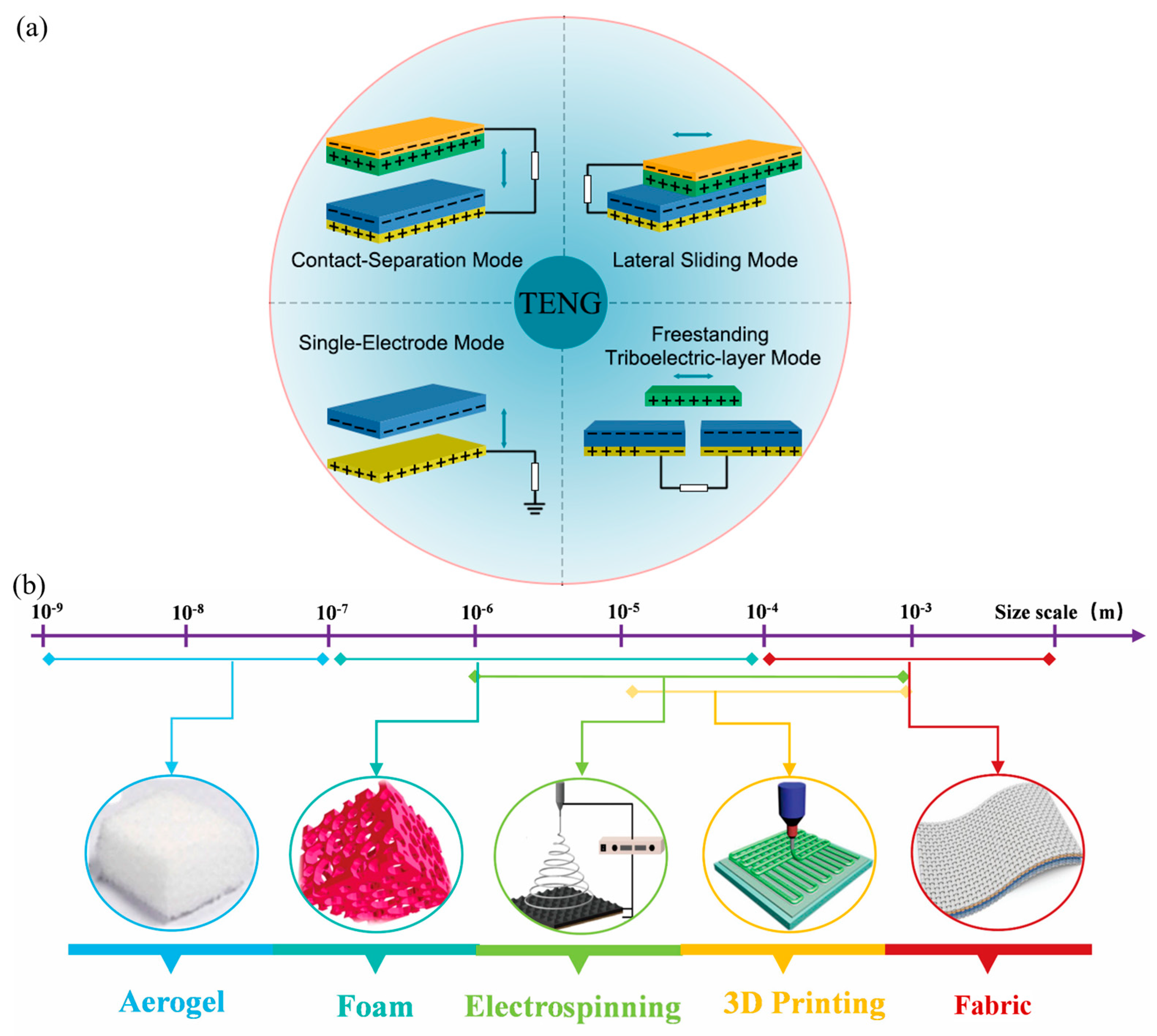
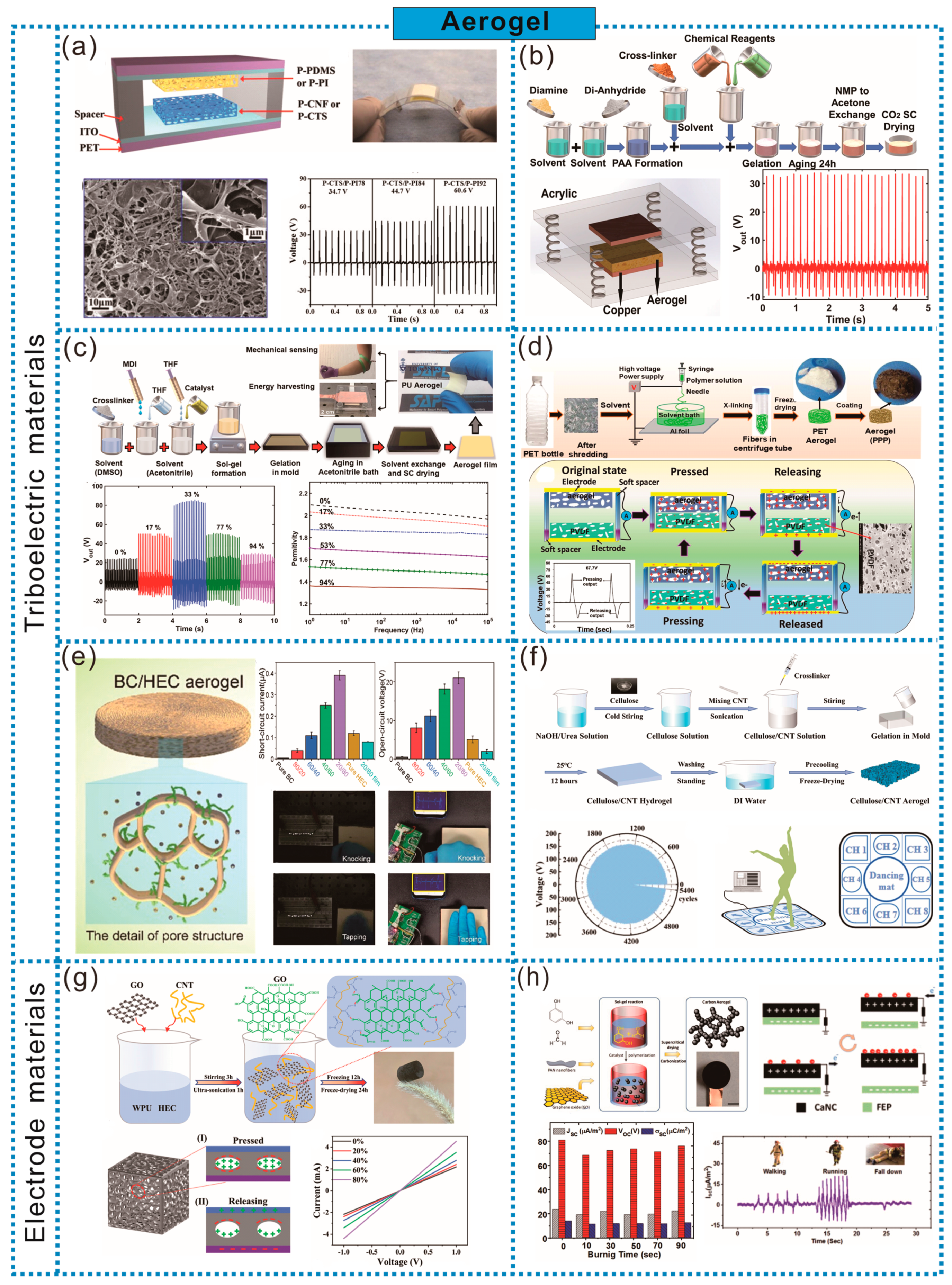


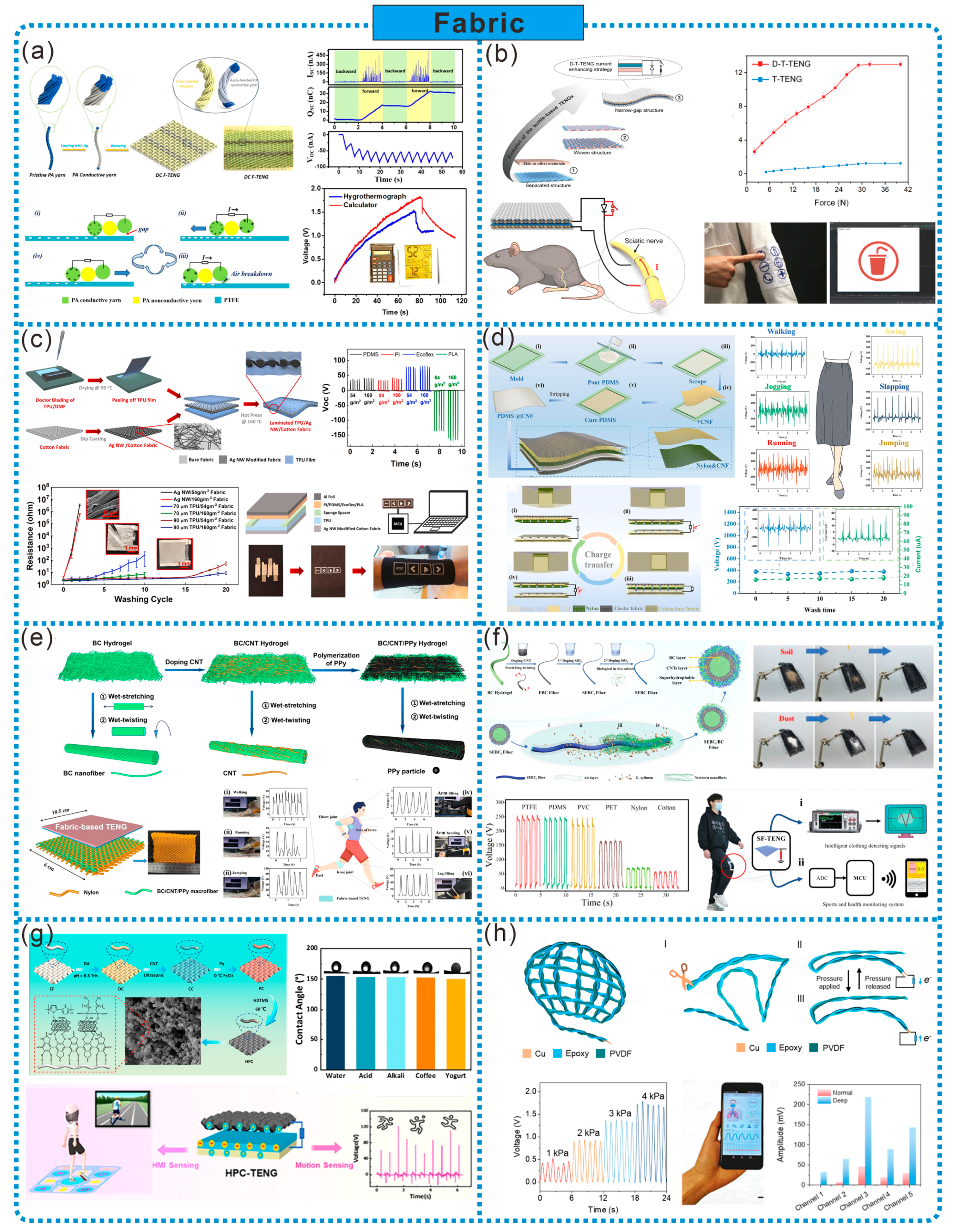
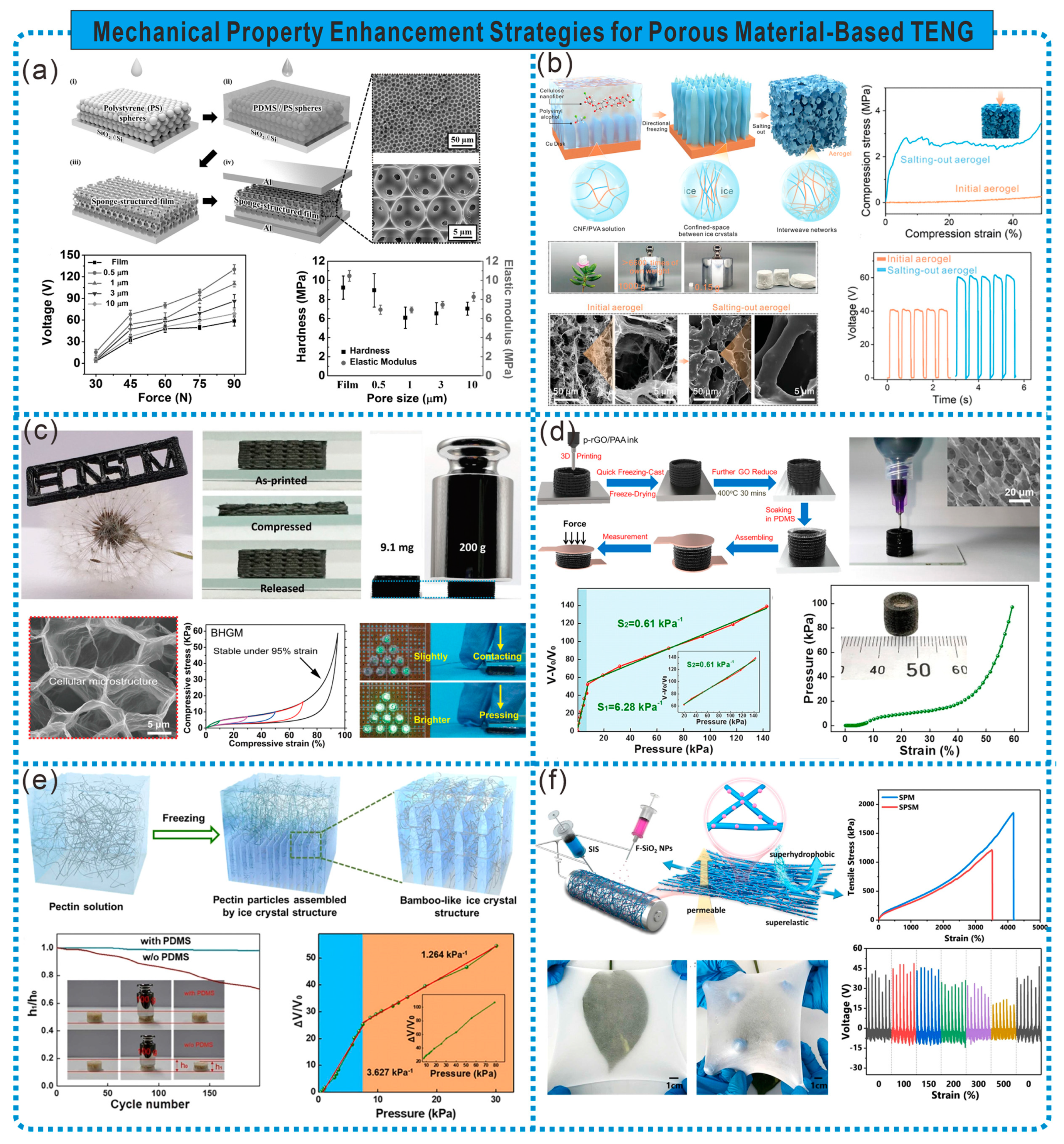




Disclaimer/Publisher’s Note: The statements, opinions and data contained in all publications are solely those of the individual author(s) and contributor(s) and not of MDPI and/or the editor(s). MDPI and/or the editor(s) disclaim responsibility for any injury to people or property resulting from any ideas, methods, instructions or products referred to in the content. |
© 2024 by the authors. Licensee MDPI, Basel, Switzerland. This article is an open access article distributed under the terms and conditions of the Creative Commons Attribution (CC BY) license (https://creativecommons.org/licenses/by/4.0/).
Share and Cite
Duan, Z.; Cai, F.; Chen, Y.; Chen, T.; Lu, P. Advanced Applications of Porous Materials in Triboelectric Nanogenerator Self-Powered Sensors. Sensors 2024, 24, 3812. https://doi.org/10.3390/s24123812
Duan Z, Cai F, Chen Y, Chen T, Lu P. Advanced Applications of Porous Materials in Triboelectric Nanogenerator Self-Powered Sensors. Sensors. 2024; 24(12):3812. https://doi.org/10.3390/s24123812
Chicago/Turabian StyleDuan, Zhengyin, Feng Cai, Yuxin Chen, Tianying Chen, and Peng Lu. 2024. "Advanced Applications of Porous Materials in Triboelectric Nanogenerator Self-Powered Sensors" Sensors 24, no. 12: 3812. https://doi.org/10.3390/s24123812




